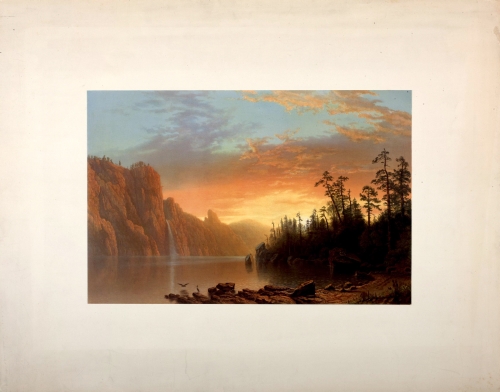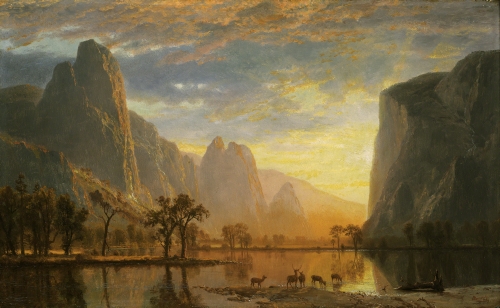Painting or Print? Albert Bierstadt
Yes, Sunset (California Scenery) is a print. But, what a print! I will admit, before I learned a little bit about art when in college, I would have seen such a chromolithograph in an antique shop and have thought that it was a painting. “Prang’s American Chromos. ‘The Democracy of Art’…” is how these prints were advertised, because the printing process Prang developed was by far the finest chromolithography available at the time.
And, by the late 1800s, homes all over America were decorated with these chromos, in lieu of the more expensive oil paintings. These prints are yet another fascinating chapter in, what I call, the IAHOA (eeyah-howah) – Incredible Art History of America.
 |
| Copy after Albert Bierstadt (1830–1902, United States, born Germany), printed by Louis Prang and Company (1824–1909, born Germany, firm 1860–1897 Boston), Sunset (California Scenery), 1868. Chromolithograph on paper, printed area: 12 5/16” x 19 9/16” (31.3 x 49.8 cm). © American Antiquarian Society, Worcester, MA. (AAS-155) |
 |
| Albert Bierstadt (1830–1902, United States, born Germany), Valley of Yosemite, 1864. Oil on paperboard, 11 7/8" x 19 1/4" (30.2 x 48.9 cm). © MFA, Boston. (MFAB-377) |
The Hudson River School artists opened Americans’ eyes wide to the natural beauty of our new country starting in the 1830s. The aim of these artists was not only to inform, but to inspire. So, we can forgive them if they fudged placement of landscape elements in order to form spectacular compositions, complete with dramatic weather or lighting. It is only natural that some of the artists associated with that “school” would seek bigger and more glorious landscapes to wow their eastern patrons. The opening of the American West was a perfect opportunity for them to load up on spectacular subject matter. Those artists who painted scenery of the West in the traditional romantic-realist style of the Hudson River School are sometimes labeled the Rocky Mountain School. Since one of Bierstadt’s huge paintings of Yosemite sold for the unheard of price of $45,000 in the 1860s, these beautiful paintings were out of reach to everyday art enthusiasts, and, so, a market was born…for chromolithographs.
Louis Prang, born in Germany, learned the printing processes from his printer father. He immigrated to the US in 1850, forming his own printing concern in 1860 in Boston. His initial profit came from “art bits,” small copies of fine art oil paintings and watercolors that were “sold in all picture stores,” and usually stored in albums. What he pioneered were large format, multi-stone chromolithographs that made amazingly faithful copies of original paintings. For some of his premium quality (and priced) prints, called “Prang’s Prized Babies,” as many as 19 litho stones were used—that’s 19 different colors layered over one another! Prang used oil-based pigments, which created a textured, built up surface that, to the untrained eye, mimicked a real painting.
Prang’s chromos were praised by press and public alike. He also developed specialty items, such as chromolithographic Christmas cards, which were his invention. In the late 1860s he published “Prang’s Chromo: A Journal of Popular Art,” issuing copies of popular American paintings called “Prang’s American Chromos.” They were based on watercolors and oil of then-popular American artists. So popular were Prang’s prints, that he commissioned some painters to produce series of paintings from which copies for chromos were made. Painters of the West such as Thomas Moran (1837–1926) and Albert Bierstadt were commissioned to fulfill this task.
Sunset (California Scenery) is probably one of the paintings commissioned by Prang for copying by his legion of lithograph artists. These artists must have been incredibly talented people, because this chromo is simply stunning, and really mirrors Bierstadt’s dramatic Luminist depiction of the West. Bierstadt, a fellow immigrant from Germany had made two trips to the West, to the Rockies in Wyoming in 1859, and all the way to California and the Pacific Northwest in 1863. He made hundreds of drawings and oil sketches along the way, which he transformed into enormous studio canvases, sometimes as wide as 10 feet! From the earliest point in his painting career he loved painting mountains, visiting the White Mountains in New Hampshire often for subject matter. Starting in 1853, he spent four years in Germany honing his naturalism skills by painting alpine scenery. It is little wonder that his stupendous depictions of Western scenery convey his enthusiasm and wonder at America’s natural beauty.
Although the chromolithograph fad faded in the last decade of the 1800s—mostly because cheap, mass-produced prints flooded the market—Prang had done the most to establish the market. His high-quality, beautiful prints (over 800 subjects during the firm’s run), like the Hudson River School, opened people’s eyes in post-Civil War (1860–1865) America to the splendor of the American West.
Correlations with Davis Programs: Explorations in Art Grade 1: 4.21, 4.Connections; Explorations in Art Grade 2: 1.4, 1.5; Explorations in Art Grade 3: 5.28; Explorations in Art Grade 4: 4.21, 4.22; Explorations in Art Grade 6: 2.8, 2.7-8 Studio; A Personal Journey: 5.4; A Community Connection: 5.4, 6.2; A Global Pursuit: 7.1; Experience Painting: 6; Experience Printmaking: 6; Exploring Painting: 7, 11; Exploring Visual Design: 4, 8, 9; The Visual Experience: 9.3, 9.4, 16.4; Discovering Art History: 12.2

Comments